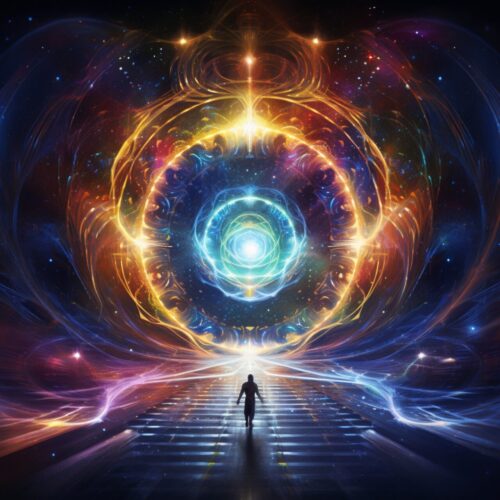The Blueprint of Reality: Decoding Plato's Ideas, Forbidden Choice, and the Science of Parallel Worlds
Introduction: Peering Beyond the Veil of Perception
Does reality truly end at what we can observe? The philosophical concept of the World of Ideas, the moral lesson of the Forbidden Fruit, and the revolutionary physics of Parallel Worlds all converge to challenge our fundamental assumptions about existence. These three pillars offer profound insights into the nature of truth, the weight of human choice, and the boundless potential of the universe. To explore these concepts is to actively question the very structure of the world we inhabit.
This comprehensive article will synthesize these deep mysteries, detailing Plato's theory of the Ideal World, the symbolic meaning of knowledge and consequence, the scientific and imaginative aspects of alternate realities, and the shared themes of invisible truth and the power of decision-making that tie them together.
1. The World of Forms: Plato’s Concept of Higher Reality
Plato's World of Ideas introduces the radical notion that the material world we interact with is merely an imperfect reflection of a perfect, unseen realm.
Unraveling the Ideal Blueprints
The World of Ideas (or Forms) is a cornerstone of ancient Greek philosophy, proposed by Plato. It posits that beyond the fleeting, physical world we experience, there exists a perfect, eternal realm where the true, ultimate Forms or Ideals of all things reside. These Forms are the perfect blueprints of concepts like Beauty, Justice, and, indeed, every physical object.
Shadows on the Wall
Plato suggests that every tangible object in our physical world is only an imperfect, flawed copy of its perfect counterpart in the World of Forms. For instance, any beautiful flower you see is just a shadow of the perfect, eternal "Ideal Flower." This challenges us to consider that the world we perceive daily is not the ultimate reality, but merely a reflection of a deeper, immutable truth.
2. The Genesis of Choice: The Symbolism of the Forbidden Fruit
The biblical story of the Forbidden Fruit is one of the most powerful metaphors in human culture, representing the moment consciousness gained moral autonomy.
Knowledge and Responsibility
The narrative of Adam and Eve and the Forbidden Fruit marks humanity's acquisition of knowledge and free will. By consuming the fruit, they gained awareness of good and evil, instantly acquiring the ability to make choices, alongside the immediate responsibility and consequences that accompany self-awareness.
The Weight of Decision
The story remains a timeless metaphor for human decision-making. Every choice we make, large or small, simultaneously opens new possibilities while committing us to a specific path and its resulting challenges. The concept of the Forbidden Fruit powerfully reminds us to be mindful and conscious of the long-term impact of our actions on our future reality.
3. Infinite Possibilities: The Science and Imagination of Parallel Worlds
Modern quantum mechanics provides a scientific framework for a concept that has long captivated the imagination: the existence of countless alternate realities.
Quantum Multiverse Theories
The hypothesis of Parallel Worlds suggests that numerous versions of reality may exist simultaneously. Within quantum mechanics, the Many-Worlds Interpretation proposes that every single choice or quantum event causes the universe to "branch," creating a new, alternate reality. Under this theory, an infinite number of alternate worlds, or a multiverse, could exist.
Alternate Selves and Destiny
This is a profoundly fascinating concept in both theoretical science and popular fiction. If such worlds exist, then countless other versions of ourselves may be living out realities where we made different choices—where destiny is fluid and infinite. Parallel Worlds propose that every decision we make instantly creates an alternate version of the universe.
4. The Core Truths: Invisible Reality and Human Autonomy
Despite their disparate origins, these three concepts converge on two fundamental themes that shape our understanding of existence.
The Unseen Architecture
All three concepts underscore the existence of an Invisible Truth:
-
World of Ideas: Suggests an unseen, perfect, and ultimate reality.
-
Forbidden Fruit: Represents the acquisition of hidden knowledge.
-
Parallel Worlds: Proposes that other realities may exist just beyond our perception.
The Centrality of Choice
Furthermore, they universally affirm the Power of Choice:
-
World of Ideas: Challenges us to make conscious choices to seek higher truths.
-
Forbidden Fruit: Symbolizes the inherent freedom and cost of human choice.
-
Parallel Worlds: Implies that every decision is a critical juncture that creates a new path.
Summary: Living with Deeper Awareness
The philosophical concepts of the World of Ideas, the moral teaching of the Forbidden Fruit, and the scientific hypothesis of Parallel Worlds provide powerful lenses through which to view reality, knowledge, and consequence. They serve as a constant reminder that what we perceive is often not the full truth, and that our decisions are the most powerful forces shaping our future. By integrating these perspectives, we gain valuable insights: to seek ideals, to be mindful of consequences, and to appreciate the limitless possibilities of our existence. Embrace these mysteries to live more meaningfully, seeing beyond the surface of everyday life and utilizing the immense power of your choices.

